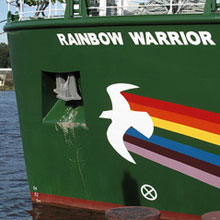
“This earth is not a resource, it’s a relationship. It’s a love story – that’s what the earth is”, says singer Regina Lund in this video for Greenpeace on the Rainbow Warrior boat. What is perplexing is why so few environmental organisations have gotten to grips with telling that love story, or with storytelling more generally.
Just a few google searches reflect what I mean. Many storytelling links are about using storytelling techniques to get greater visibility for corporate brands. This is not good news for environmental organisations with more limited resources. With the rise of all things digital, there’s ever growing competition to get heard.
As Jonah Sachs says in his Winning the Story Wars, audiences are “more sceptical and resistant than at any time in history.” But, if we can inspire them, “they are willing and able to spread their favorite messages, creating a massive viral effect for those who win their love.”
So I thought I’d look at the Stories from the Rainbow Warrior film series produced by Greenpeace (which, let’s face it, has storytelling nailed). The short films or vigenettes set on the famous Greenpeace ship are of ‘hero’ characters working on the ship.
It’s a bit like BBC 4’s Archers, but set on the high seas. Originally billed as an everyday story of country folk, the Archers are a quintessential radio soap opera of middle England. The characters take us behind the closed doors of rural English life, just as a series of short films produced by Greenpeace reveal, film by film, the lives of the crew on the Rainbow Warrior.
We get a glimpse of what life is like through the eyes of the “jailhouse rockstar” aka Paul Simonon, former bassist for The Clash, who was an assistant chef on the boat. In another, a ship hand is clearly struggling with the rigid schedules of the ship and the way men dominate the deck (in her opinion anyway). The villains in the films are mostly unseen but represented in footage of oil rigs, or in footage of police entering the Rainbow Warrior. The conflict is over the earth’s resources and the films have a clear moral message: “We can’t continue to exploit the earth as we’re doing, and we will stand up to further exploitation.”
Not everyone liked the behind the scenes films. In the second video called “I am not a ship person”, for example, Helene says “fuck” a few times which, it seems, created some negative feedback within Greenpeace, according to this blog written by a seasoned Greenpeace campaigner. Brian Fitzgerald says the project was “born out of a frustration among our Communications folks worldwide with the fact that for an organisation so full of stories, we’re sometimes very bad at storytelling.”He says these videos are less editorially controlled as that kind of control “robs our audience of a certain honest true grit”.
It’s an example of the clash between polished corporate communications image and the slightly rougher behind the scenes reality, which I would hazard to guess resonates better with Greenpeace’s supporters. It’s comforting to know that even in an organisation as groundbreaking as Greenpeace’s that this constant tension between truthful and realistic storytelling and the sanitised version that gets published exists.
Metaphor and myth for a stronger storytelling brew
But the most effective films used strong language and myth to move beyond simple character vignettes to something stronger, which is Sach’s key point in his book (and which I’ll cover more in my next blog). Singer Regina Lund, who I quoted at the start of this blog, was memorable because she used a metaphor to describe what she hopes is a changing relationship to the earth – from exploitation to a love affair.
And some of the films add to the mythology surrounding Greenpeace. Films like this director’s cut video of the old Rainbow Warrior build a picture of the ship as a brave warrior, a witness and activist – in other words she embodies the spirit of Greenpeace itself. This is shown in the language used in this news story describing the ship’s “struggles and victories for the environment, of the activists who walked these decks, of the places she’s been and the people she’s touched.”
Another film told through the eyes of Harmony Lambert, a deckhand with native American roots and raised in the Chumash native American tradition, gets to the origins of Greenpeace and the ship’s name, which was inspired by William Willoya’s and Vinson Brown’s Warriors of the Rainbow. She shares a Cree prophecy that effectively embodies the meaning of activism for her and many others: that the earth “will start to poison us” and everyone in the world will have to stand up together and be “warriors of the rainbow”.
While the films may appear rough around the edges, the films are actually carefully put together to deepen your sense of connection and understanding of Greenpeace and its values – it’s a potent storytelling mix.
Have you watched the films – what was your reaction to them? What other great environmental storytelling is out there? Get in touch so we can learn and share.
